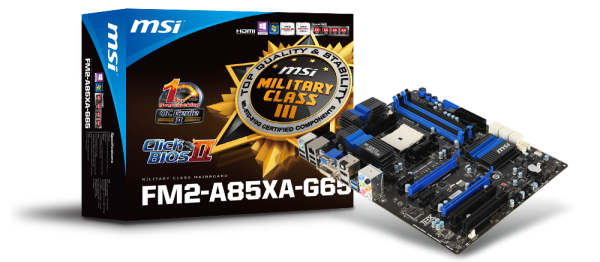MSI FM2-A85XA-G65 Review: Know Your Platform
by Ian Cutress on December 11, 2012 1:21 AM EST- Posted in
- Motherboards
- MSI
- FM2
- A85X
When looking at a motherboard for the first time, my initial thoughts tend towards two areas. Firstly, does it look like it would be a good performer – there is a certain level of confidence that comes from a positive aesthetic perspective, and if it looks like a dump it would probably act like one. The second thought is usually geared towards the PCIe layout, and I imagine trying to place two GPUs and a sound card (either PCI or PCIe x1). Some manufacturers have an odd way of designing this layout, optimizing it for build time rather than usability. Thankfully though, MSI does sort of reasonable on both accounts.
Visually the board is sleek and seems uncluttered compared to most motherboards, despite the features on board. We get access to power/reset buttons, easy access voltage read points, a full eight SATA ports, five fan headers, the full array of video outputs and that all important PCIe layout for two GPUs + one or two extra devices. In contrast, we do not get a two-digit debug LED, the memory slots are not single latched, the USB 3.0 port is in an odd place in the middle of the board, two of the SATA ports could be blocked by a second GPU, and there are no extra controllers for functionality.
On the hardware side we get a Realtek audio/NIC combo with the ALC892 and 8111E respectively. Previous A85X motherboards tested at AnandTech use a total of three full-length PCIe slots whereas the MSI uses two to optimize usage scenarios with PCI and PCIe x1 slots.
The BIOS design is good in giving the important information, albeit the wall of options in the OC menu could take some getting used to. The fan controls are basic at best, and the automatic OC control leaves a lot to be desired when pushing the performance of a Trinity system. Manual overclocking performance with automatic LLC was not spectacular either.
One of the best bits of the MSI motherboard is the software, with the Live Update software making sure the system is up to date, and the Control Center for all things information, detection and control. The Click BIOS system is great to introduce users to the BIOS while still being in the comfort of a full operating system.
Due to the ‘bug’ in the BIOS relating to top turbo speed and actually getting it to initiate, there are aspects to the performance where the MSI may have spent more time fine tuning or developing a different aspect of implementation. Despite this, multi-threaded performance seems to be fine. The system could be better in terms of DPC Latency (329 microseconds, ideally should be under 200) and time to POST (16.75 seconds), relating back to fine tuning. I should point out that improvements could come with a later BIOS than what was tested here.
At $100, the MSI FM2-A85XA-G65 actually falls on the cheaper end of the range of FM2/A85X motherboards available. The MSI has some tough competition and does not really pull itself away from the rest of the pack unless you want easy-to-use physical read points or a nice system of additional software to deal with. When the results are placed side by side with some of the cheaper FM2 boards we have tested, the performance/price scales are often in favor of the competition, leaving the MSI as a choice if you are really gunning for an MSI build.
Addendum 11/12/2012: Based on the findings in this review, MSI have released a BIOS update to v1.4 which should fix the turbo core issue. The issue was related to the default choice of the C6 state in BIOS 1.3 which was disabled. It should be enabled in BIOS v1.4, or users of the 1.3 BIOS can manually change the BIOS option to get the stock performance back on track. We will hopefully release a news update with the latest benchmark results in due course.











11 Comments
View All Comments
Wwhat - Wednesday, December 12, 2012 - link
Perhaps if they can't deliver PCIe3.0 they could make it supply the higher power feed from the PCIe3.0 specs at least? Just am off the cuff marketing idea, feel free to use it0